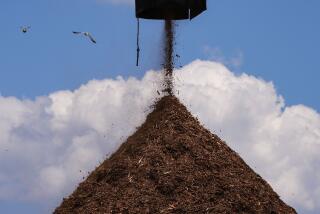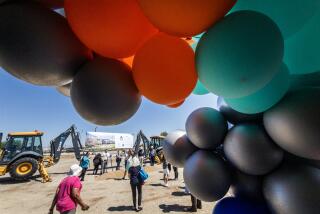Can Garbage Be Useful? City Testing Swiss System
The first time R.J. Casale tried to fly 82 bags of trash to Switzerland, the airline got cold feet at the last minute. Maybe the stuff was hazardous, airline officials explained edgily. Worse yet, maybe it would smell.
The second time around, Casale wised up. He went to another airline and declared 82 bags of “used material.” The trash made it to New York City, where it had to transfer. Then an airline official queried suspiciously: “What kind of used material?”
“Used cans and used paper products,” Casale recalls telling him. “Used bone material. Used rubber.”
What’s it for? the man asked. Experimentation, Casale explained. The man waved the stuff through.
Late last month, the “used material” returned to San Diego, reduced by two-thirds of its weight and transformed into small brown pellets. Now the pellets are to be scrutinized as part of an experimental waste-disposal system being proposed to the city of San Diego.
Under the system, being developed in Switzerland and France, trash is shredded and crushed, then mixed with minerals or chemicals and “pelletized.” As Casale puts it, “If you can envision in your mind, let’s say, dry dog food . . . “
Then, its developers hope, the pellets might be re-used for such things as building blocks, wall board and sub-base for roads. If that proves possible, they say, their system may offer an ecologically sensitive, economically viable alternative to incineration.
“We believe it can be used with less pollutants into the atmosphere than the burn process,” said Casale, who describes himself as a San Diego entrepreneur and investor currently promoting the process here. “. . . Also, because this is a pretty complete process, you wouldn’t need a landfill.”
With landfill space steadily running out in San Diego, the pelletization scheme has attracted interest from the City Council. Its promoters suggest it could complement--or even replace--the giant trash burner that has won the council’s tentative support, but has encountered public opposition.
Much of the opposition to the burner centers on questions about the health effects of emissions from its stack. Also, the so-called SANDER plant would burn only half the city’s current trash and would generate large quantities of ash--which would have to be deposited in landfills.
Three big questions remain about the experimental Swiss system.
First, the pellets from San Diego’s trash must be tested to determine whether they contain hazardous materials and how they might hold up over decades. Might they break down, or might the hazardous materials in them vaporize? Would they dissolve and leach into the soil?
The answers to those questions might determine, second, whether there is a market for the pellets in the United States. Without someone willing to pay for the material, the city would bear the cost of its disposal and the system would be less attractive economically.
Finally, Casale said, he is awaiting the results of air-emissions monitoring done to test his group’s premise that the process is non-polluting. He said tests were done at the pilot plant in France, but he has not yet received the results.
“It’s an intriguing process, if it in fact pans out,” Deputy City Manager Coleman Conrad said Friday. “It’s not a burning process, so it may not result in any of the emissions into the air. And if you do in fact have a marketplace for a large amount of that material, then it could substantially reduce the net costs.”
The system was developed by a French chemist named Georges Biez, said Casale. Biez is backed, he said, by a Swiss firm, Catrel S.A., which was formed for the purpose.
Under the Catrel system, trash passes through a primary crusher, then is further reduced in size by shredders and another crusher. The trash is broken down to the consistency of sand, but is lightweight, fluffy and moist, Casale said.
Next, it is mixed with minerals and heat-treated, causing a chemical reaction that Casale said renders the original materials inert. Casale declined to identify the minerals, suggesting they were proprietary. He refers to them as the “secret sauce.”
Finally, the material is formed into hard pellets.
So far, the only facility is a small pilot plant in Viry, France, a small town near the Swiss border where Biez lives. The plant has operated in demonstration projects, but skeptics wonder how well it would function when scaled up to serve a large municipal waste stream.
The pellets, too, have been used only in demonstration projects, never in real roads or in construction, Casale said. Before they could be used in this country, they would have to be approved by health, highway and building code authorities.
But last year, Catrel officials made a presentation of the firm’s process to a committee of the San Diego City Council, which expressed interest in the process and helped arrange for some trash from San Diego to be tested in Viry. Last month, at Catrel’s expense, approximately 1,000 pounds of trash were flown from Lindbergh Field to Geneva via New York City.
The trash was carefully selected by a trash contractor to represent accurately the precise makeup of San Diego’s refuse: 19.6% yard waste, 25.1% paper products, 1% aluminum, 1.9% combustibles, 5% ferrous metals, 6.4% newspaper, 6.5% glass, 7.4% plastic, 9% corrugated material and 18.1% other combustibles.
It was accompanied by an employee of the county Department of Health Services, David Marx, who flew to Geneva and went with the trash to Viry to insure that what was processed was truly San Diego’s. For the return journey, Marx put special seals on the bags of pellets and saw them off. His office alone was authorized to bring them through customs.
Now the pellets are to be analyzed in California for hazardous materials such as heavy metals and volatile organics, said Marx. His office, he said, will take samples of the pellets Catrel tests and do its own testing in state labs.
“The critical determining factor is whether the aggregates are usable and can be marketed, and whether the processing costs are reasonable,” said Marx. He and Casale said it would take 60 to 90 days to get results from the lab tests.
For the time being, the Catrel process has been received here with cautious optimism.
Councilwoman Gloria McColl, a council member closely involved in the decision-making process for the SANDER trash burner, visited the pilot plant while on vacation in Europe. According to an aide, McColl is interested in the system as a complement to the bigger plant.
Possible Alternative
“The councilwoman’s concern is that even with SANDER there is going to be a time when we are going to have to look at other ways of disposing of our trash,” said the aide, Marla Marshall. “Her feeling is that we should have some foresight and look at every possible alternative.”
A similar position was taken by Janet Brown, a community activist who has spearheaded much of the opposition to the SANDER project. “The point is, if it’s a non-polluting technology, then I think it’s definitely something that should be evaluated,” she said of the Catrel system.
Even advocates of SANDER urged exploration of all alternatives.
Frank Mazanec, the engineer who is regional director of Signal Environmental Systems, the company that would build the burner, said the technology proposed by Catrel sounds quite feasible, in that it is not unlike some existing systems.
Economics Questioned
He said he had questions about the economics of the process and doubted whether waste could be disposed of at the $12.80-per-ton price promised by SANDER. He also questioned whether the system would be pollution-free, or simply would shift the pollution to a different medium.
But Mazanec said he, for one, was following the process closely--not the least because its pelletization process might hold an answer for the ash produced by SANDER. He acknowledged, too, that his system can only handle a portion of the city’s waste.
“I don’t think any one technology is the total solution,” said Mazanec. “It’s like an investment portfolio: You’re looking for balance.”
More to Read
Sign up for Essential California
The most important California stories and recommendations in your inbox every morning.
You may occasionally receive promotional content from the Los Angeles Times.










